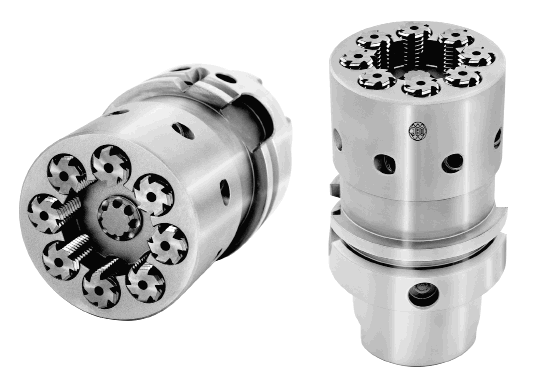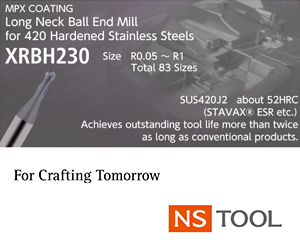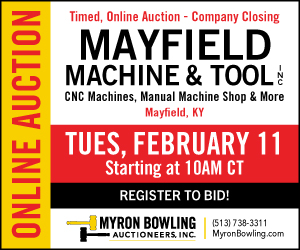In 1933, Sabin Mitchel and John Scott hired five workers, rented space in a small building in northeast Indianapolis and launched the Mitchel & Scott Machine Co. to make parts for heavy machinery.
It was a tough time for hopeful beginnings. More than 4,000 banks failed during the first two months of 1933, 14 million Americans were jobless and manufacturing, down nearly 50 percent from its 1929 mark, was in a freefall.
The fact that Mitchel & Scott persevered and prospered during the ensuing 76 years—compiling a client list that includes Cummins Engine, John Deere, Delta Faucet, Mack Trucks, Caterpillar Tractor and Ingersoll Rand—might owe as much to Depression-forged lessons as business acumen and craftsmanship.

The a JBO GFG-WFE shell-type thread milling cutter features eight cutters, which can be indexed six times.
“My dad (Dave Mitchel, company president) and his brothers, Tom and Steve, were good businessmen and very frugal,” said Jim Mitchel, director of manufacturing. “They were always prepared for hard times, and I know they learned that from my grandfather Sabin.” (Sabin Mitchel bought out John Scott’s share in the company in 1955.)
That prudence also extends to keeping a vigilant eye on ways to increase productivity and streamline processes. One recent example occurred in early 2008, when Mitchel & Scott saw a chance to improve an external threading operation.
The company had been using a CNC multispindle machine to make a family of parts for bulldozers. One of the applications involved the external threading of a 10-18 steel hydraulic port for a hydraulic cylinder. The job called for a 13⁄16-16 UNF 2A thread, 12mm long. Single-point threading on the multi-spindle provided a 14-second cycle time.
But company executives had decided to reassign the CNC multispindle machine to its plug-making operation. They contacted machinery maker Hydromat Inc., St. Louis, for replacement machinery to handle the bulldozer parts and, in particular, improve the hydraulic port external threading time.
Hydromat recommended its Epic 45-12 rotary transfer machine equipped with a GFG-WFE shell-type thread milling cutter from JBO-USA, Troy, Mich., according to Dale Toews, Hydromat regional sales manager. The GFG-WFE head includes eight carbide cutters, which can be indexed six times. Toews said the company demonstrated the JBO product on an Epic 45-12 in a stainless steel application during EMO 2007, and had been impressed with its performance.
To ensure proper thread milling of the hydraulic port, JBO designed the cutter. “Hydromat sent me the part print for the port, and JBO engineers in Germany worked up the design for the thread milling head and carbide inserts,” said Joe Mazzenga, sales manager for JBO-USA. “We manufactured the head with an integral HSK 40 shank. The thread is about 20.63mm in diameter and the ID of our head in this case was 26mm. So, basically, the cutter is only offset 2.69mm to begin threading.”
Hydromat delivered the rotary transfer machine equipped with the JBO head in December 2008, said Jim Byrum, Mitchel & Scott manufacturing engineer. “It’s a big change [from the multi-spindle machine],” he added. The JBO GFG-WFE cut the external thread milling cycle time from 14 seconds to 9 seconds. In addition, because the JBO produces 50,000 to 60,000 parts before indexing (vs. 5,000 to 6,000 parts for the single-point tool), the new technology reduces downtime, while offering 10 times the tool life.
“The unit itself is mounted on a 2-axis flange, and there’s a third axis, the Z-axis, that’s on the spindle,” said Byrum. “The head spins in the spindle at roughly 2,000 rpm. When we thread mill this part, we go in over the part to the actual depth we want the thread to be, and then we helically interpolate around the OD of the part as the Z-axis on the spindle is feeding in at the pitch of the thread.”
The machine’s easy operation is an added plus, continued Byrum. “Once you index those cutters and dial it to the right size, the machine is CNC so you’re just making an offset. You basically don’t have touch anything for about 50,000 to 60,000 pieces; it just sits there and hammers out the parts.” CTE
Related Glossary Terms
- computer numerical control ( CNC)
computer numerical control ( CNC)
Microprocessor-based controller dedicated to a machine tool that permits the creation or modification of parts. Programmed numerical control activates the machine’s servos and spindle drives and controls the various machining operations. See DNC, direct numerical control; NC, numerical control.
- family of parts
family of parts
Parts grouped by shape and size for efficient manufacturing.
- gang cutting ( milling)
gang cutting ( milling)
Machining with several cutters mounted on a single arbor, generally for simultaneous cutting.
- inner diameter ( ID)
inner diameter ( ID)
Dimension that defines the inside diameter of a cavity or hole. See OD, outer diameter.
- milling
milling
Machining operation in which metal or other material is removed by applying power to a rotating cutter. In vertical milling, the cutting tool is mounted vertically on the spindle. In horizontal milling, the cutting tool is mounted horizontally, either directly on the spindle or on an arbor. Horizontal milling is further broken down into conventional milling, where the cutter rotates opposite the direction of feed, or “up” into the workpiece; and climb milling, where the cutter rotates in the direction of feed, or “down” into the workpiece. Milling operations include plane or surface milling, endmilling, facemilling, angle milling, form milling and profiling.
- milling cutter
milling cutter
Loosely, any milling tool. Horizontal cutters take the form of plain milling cutters, plain spiral-tooth cutters, helical cutters, side-milling cutters, staggered-tooth side-milling cutters, facemilling cutters, angular cutters, double-angle cutters, convex and concave form-milling cutters, straddle-sprocket cutters, spur-gear cutters, corner-rounding cutters and slitting saws. Vertical cutters use shank-mounted cutting tools, including endmills, T-slot cutters, Woodruff keyseat cutters and dovetail cutters; these may also be used on horizontal mills. See milling.
- milling machine ( mill)
milling machine ( mill)
Runs endmills and arbor-mounted milling cutters. Features include a head with a spindle that drives the cutters; a column, knee and table that provide motion in the three Cartesian axes; and a base that supports the components and houses the cutting-fluid pump and reservoir. The work is mounted on the table and fed into the rotating cutter or endmill to accomplish the milling steps; vertical milling machines also feed endmills into the work by means of a spindle-mounted quill. Models range from small manual machines to big bed-type and duplex mills. All take one of three basic forms: vertical, horizontal or convertible horizontal/vertical. Vertical machines may be knee-type (the table is mounted on a knee that can be elevated) or bed-type (the table is securely supported and only moves horizontally). In general, horizontal machines are bigger and more powerful, while vertical machines are lighter but more versatile and easier to set up and operate.
- outer diameter ( OD)
outer diameter ( OD)
Dimension that defines the exterior diameter of a cylindrical or round part. See ID, inner diameter.
- pitch
pitch
1. On a saw blade, the number of teeth per inch. 2. In threading, the number of threads per inch.
- rotary transfer machine
rotary transfer machine
Type of CNC machine tool for high-volume, extended-length production runs of a family of parts. A workpiece is transferred from station to station in a rotary fashion and a tool or tools at each station performs one or more operations until the part is completed.
- sawing machine ( saw)
sawing machine ( saw)
Machine designed to use a serrated-tooth blade to cut metal or other material. Comes in a wide variety of styles but takes one of four basic forms: hacksaw (a simple, rugged machine that uses a reciprocating motion to part metal or other material); cold or circular saw (powers a circular blade that cuts structural materials); bandsaw (runs an endless band; the two basic types are cutoff and contour band machines, which cut intricate contours and shapes); and abrasive cutoff saw (similar in appearance to the cold saw, but uses an abrasive disc that rotates at high speeds rather than a blade with serrated teeth).
- shank
shank
Main body of a tool; the portion of a drill or similar end-held tool that fits into a collet, chuck or similar mounting device.
- threading
threading
Process of both external (e.g., thread milling) and internal (e.g., tapping, thread milling) cutting, turning and rolling of threads into particular material. Standardized specifications are available to determine the desired results of the threading process. Numerous thread-series designations are written for specific applications. Threading often is performed on a lathe. Specifications such as thread height are critical in determining the strength of the threads. The material used is taken into consideration in determining the expected results of any particular application for that threaded piece. In external threading, a calculated depth is required as well as a particular angle to the cut. To perform internal threading, the exact diameter to bore the hole is critical before threading. The threads are distinguished from one another by the amount of tolerance and/or allowance that is specified. See turning.









